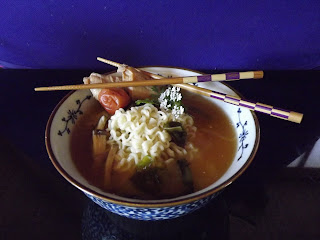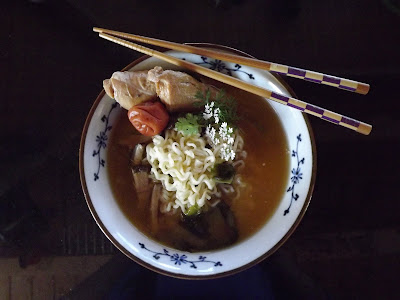Miso Soup and yummy things!
I LOVE Miso soup. It is, as far as I am concerned, the most perfect of all Japanese foods. There are literally dozens of things that the Japanese People add to their Miso soup: from Asari Clams (which are tough o find in the USA) to ramen noodles and everything in between. Here is what WIKIPEDIA has to say about Miso Soup and a few Japanese ingredients for adding to it.
From Wikipedia, the free encyclopedia
The most common dashi soup stocks for miso soup are made of niboshi (dried baby sardines), kombu (dried kelp), katsuobushi (thin shavings of dried and smoked bonito, aka skipjack tuna), or hoshi-shiitake (dried shiitake). The kombu can also be used in combination with katsuobushi or hoshi-shiitake. The kelp and/or shiitake dashi serve as a vegetarian soup stock.
According to Japanese custom, the solid ingredients are chosen to reflect the seasons and to provide contrasts of color, texture, and flavor. Thus negi and tofu, a strongly flavored ingredient mixed with a delicately flavored ingredient, are often combined. Ingredients that float, such as wakame seaweed, and ingredients that sink, such as potatoes, are also combined. Ingredients can include mushrooms, potatoes, seaweed, onion, shrimp, fish, and grated or sliced daikon. Nearly any Japanese ingredient is added to some type of misoshiru. However, misoshiru does not typically contain many ingredients beyond the stock and miso.
If pork is added to miso soup, it is called tonjiru, meaning "pork soup".
So Yesterday I made a Hokkaido specialty called Miso Ramen. Hokkaido is the northernmost of the four main Islands of Japan. Because the weather there is very cold for most of the year, heartier preparations of traditional Japaense favorites are comon. By adding Ramen noodles to the soup it is made thicker, and heavier, and will keep the person who eats it warmer for longer. Even though it's still summertime here in Tehachapi, I had a craving-so miso ramen was on the menu! My recipe calls for some fairly untraditional ingredients, but I've never known my Japanese friends to mind the American alterations!
Here is the recipe!
Miso Ramen
(Dashi Broth)
1 gram package of Bonita flakes
1, 6 inch square of dried kelp (KOMBU)
5 cups cold water
2 dried shiitake mushrooms (optional)
Place the kelp in the bottom of a stock pot. Pour the cold water over the kelp, and add the mushrooms. turn the heat to medium-high and bring to a gentle boil.
Remove the kelp and discard (or save for another use). Remove the pot from the heat and sprinkle the Bonita flakes over the water.
Allow the mixture to rest undisturbed for 6 minutes-until the flakes all sink to the bottom. Strain the mixture through a fine mesh strainer into a clean bowl. Pull out the mushrooms, slice thinly, and return to the broth. Discard the Bonita flakes.
This is Dashi Broth! If this looks too daunting for you to try at home-just use vegetable or chicken stock. Trust me, though, the effort you put into your Dashi will reward you with amazing flavor and true Japanese authenticity. From here you can use red (salty) or white (sweet) Miso according to your personal taste. I use:
1/2 cup of light red miso paste
Place the Dashi back into the cleaned stock pot. Pour about a cup of Dashi in a separate bowl and whisk into this the miso. Pour the Miso stock back into the remaining Dashi and warm very gently over meduim low heat.
That's all there is to it. This is now basic Miso Soup.
To this you can add:
noodles
chicken
pork
shellfish
seaweed (I like Wakame)
tofu
extra mushrooms
The possibilities are endless!
To mine last night I added: cooked ramen noodles (just follow the package directions for boiling), leftover teriyaki chicken, wakame seaweed, and an umeboshi (pickled plum) for tartness.
 |
| yes-this my photo. I made this soup! |
The entire process only took me 30 minutes. If you don't make your own Dashi broth, it should only take half as much time!
ITATAKIMASU!!!!!!!!!!!!!!!!!
Miso soup is well known dietary staple in Japan, contains miso paste, onions, carrots, seaweed and water. The paste is typically made from soybeans, yeast and a starch, such as rice or barley, and is aged for approximately a year. Fortunately, you can purchase aged and fermented miso, which provides several health benefits, in many specialty stores and some supermarkets.
Below are the main benefits which can be attributed to Miso soup. It is essential to make clear that weight loss through Miso soup is when this is substituted for an original meal with a higher calorie level. Miso soup cannot be added as an ‘extra’. Why not try it for your lunch?
The main health and weight loss benefits of Miso Soup are as followed:
- Miso contains many trace minerals, including zinc, manganese, and copper, which can all contribute to the strengthening of the bodies immune system.
- The high amount of nutrients present in miso helps boost energy and even protects bones and blood vessels.
- Miso
- A lot of organic compounds are found in miso, which can help reduce the risk of breast cancer.
- Miso is often recommended to vegans, since it is naturally high in protein, vitamin K, and vitamin B12.
- Miso is great for the digestive tract, as it is high in fibre and probiotics.
- Miso is a weight loss dream food as it only contains around 56 calories per one ounce serving and only two grams of fat. A cup of miso soup is both satisfying and filling, since it has a high moisture content that curbs appetite and overeating. Adding Miso soup to your everyday diet as a replacement for one of your high in fat/calorie food can significantly decrease the amount of calories you intake into your body.
- The combination of wakame seaweed and miso is said to be an effective fighter against nicotine-related disorders.
- Many believe that consuming miso soup several times a week will help you avoid illness during cold and flu season. The remedy soothes those who are already sick much like chicken soup. Antioxidants in the soup strengthen the immune system and, because miso soothes acid in the system, it helps combat viral infections.
courtesy of: http://beer-belly.co.uk/health-benefits-and-weight-loss-benefits-of-eating-miso-soup/







Comments
Post a Comment